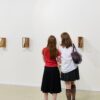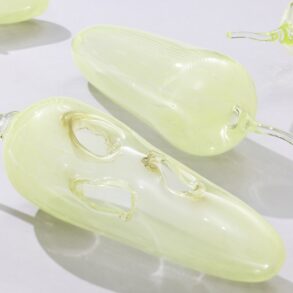Mary Sibande, “Sophie-Ntombikayise” (2009), tulle, cotton, fiberglass, cast resin (museum purchase: R. Charles and Mary Margaret Clevenger Art Acquisition Fund)
A panoply of female artists demonstrates resistance and strength in trying times
The timely “Bold Women” exhibition at the Spencer Museum of Art opened in February as a tornado of social unrest ripped through our delicate democracy and has since threatened women, people of color, immigrants and many others.
The monumental exhibition, comprising more than 75 artworks by women, takes an intersectional approach in both theme and materiality. Demonstrating resistance through portraiture, liberation through preservation, the dangers of erasure and the importance of knowledge-keeping, each artwork in “Bold Women” upholds a common thread that connects unapologetic courage and purposeful gesture.
Area artist Hong Chun Zhang’s piece “Bound” (2025) visually opens the exhibition with a striking 5 x 17-foot double-sided ink painting on Italian Alcantara fabric that investigates identity through disembodied depictions of long, black hair. In her quintessential style, “Bound” depicts chain and barbed wire to allude to the way people are contained in systems of oppression. This is especially true, Zhang argues, regarding the mistreatment of women all over the world.

“The chains reflect urban institutional/industrial and social constraints women have historically fought (and continue to fight) to overcome,” Zhang said. “The barbed wire represents rural communities and traditional restraints on women. The broken chains and loose (hair) barbed wire represent the continual fight against these rural and urban boundaries.”
South African artist Mary Sibande’s showstopping sculpture “Sophie-Ntombikayise” (2009) flaunts its innovative use of material. The sculpture transforms a typical maid’s uniform into a powerful platform through which domestic servants like those from Sibande’s own family under South African apartheid can speak.
The title indicates the practice of stripping women of their African names and providing them instead with simple Anglo names. The luxurious dress made of cotton and tulle portrays the cast resin and fiberglass figure in a moment of fantasy, dreaming of a purpose beyond servitude. The Spencer Museum is the first in the U.S. to have acquired a work by Sibande, who plans to travel to Lawrence soon to create a new piece and to work with KU students.
Rose B. Simpson, a multimedia artist based in Santa Clara Pueblo, New Mexico, credits a long line of female Tewa artists as influences on her work. In her two prints titled “Maria” (2021), she shares her understanding of automobiles as “vessels” through the depiction of a 1958 Chevy El Camino she found on the side of a road in New Mexico. She combines what she calls her “baby carriage” with the indelible tradition of black-on-black Pueblo pottery.

“I believe I am creating these pieces, but I am also creating my life, my world view,” Simpson said in a recent artist talk at KU. “In making something, I am reflecting it back to myself . . . And I think mostly it’s because I need to love myself.”
Simpson’s prints are displayed next to Pueblo matriarch Maria Martinez’s “Jar” (1915-1934) after which the El Camino “Maria” was named. This upstairs corner of the exhibition is noteworthy not only for the connection between Simpson and Martinez, but also other visual segues.
Sonia Khurana’s “bird” (1999) performance recording, displayed on the other side of the gallery, duplicates itself in the reflection of Martinez’s jar. The visual connection recalls one of the oldest myths in Greek history: Pandora’s jar, a patriarchal explanation for why women are responsible for the downfall of civilization. Khurana’s plucky performance utilizes the artist’s agile naked body to challenge social norms in India and resist gravity as she attempts to fly. Through humor and science, Khurana acknowledges the oppressive and impossible expectations placed on women and their bodies.
Material innovations are central to the exhibition, says the Spencer Museum’s curator of European and American art, Susan Earle.

“Sandra Brewster’s gel transfer photographs (2021) either deliberately blur the portrait/anti-portrait or portray incredible historical figures that are at risk of being erased such as Toni Morrison, Josephine Baker and Nina Simone,” Earle said.

Earle also highlighted Renée Fleuranges-Valdes, whose quilt “Akofena” (2022) from her Warrior Woman series “visualizes a fight against long-standing oppression of enslaved people in the U.S. and elsewhere, and envisions a future in which the power of these laborers and artisans and queens has been reclaimed for a future that creates wisdom and equality for all.”
In “Markings N. 7-3” (2007), South Korea’s Koo Kyung Sook fabricated a self-portrait by wrapping her body in faux fur doused in chemicals and imprinting those chemicals from her skin onto photosensitive paper.
Faye HeavyShield’s “blood” (2004) uses cotton and acrylic to speak about her experience of forced assimilation of Native people into white culture and the related issues of blood ties, heritage, the site of wounds, and memory. HeavyShield’s accompanying poem transcribes those visual metaphors while also referencing her cultural affiliation with the Blackfoot Confederacy from the Kainaiwa (Blood) Nation.
Canadian Lebanese artist and activist Jamelie Hassan raises questions of text translation in her multimedia work “Yeah/Neon manuscript page” (2005/2015), in which red neon light over a photograph of a page from an 18th-century Arabic/Persian grammar manuscript recalls the value of critical thinking in the context of religious and political texts or modern, neon advertisements.

The exhibition includes works by feminist pioneers and internationally known artists from the 20th century as well as contemporary luminaries. They include Firelei Báez, Jenny Holzer, Graciela Iturbide, Barbara Kruger, Viola Burley Leak, Ke-Sook Lee, Shirin Neshat, Catherine Opie, Cara Romero, Martha Rosler, Betye Saar, Miriam Schapiro, Lorna Simpson, Jaune Quick-to-See Smith, Renée Stout, Sonié Joi Thompson-Ruffin, Kara Walker, Carrie Mae Weems, Dyani White Hawk, Emmi Whitehorse and many others.
“Bold Women” is funded by the National Endowment for the Arts. It was organized by curator Susan Earle and co-developed with advisors Kimberli Gant and Wanda Nanibush, and assisted by advisors Marla A. Jackson and Rose Bryant, along with KU students Lena Mose-Vargas, Sarah Dyer, Sara Johnson and Maggie Vaughn.
“Bold Women” continues at The Spencer Museum of Art at the University of Kansas, 1301 Mississippi St., Lawrence, through July 6. Hours are 10 a.m. to 5 p.m. Tuesday, Wednesday and Friday, 10 a.m. to 8 p.m. Thursday, and noon to 5 p.m. Saturday and Sunday. Admission is free. For more information, 785.864.4710 or https://spencerart.ku.edu/.
This post was originally published on this site be sure to check out more of their content







